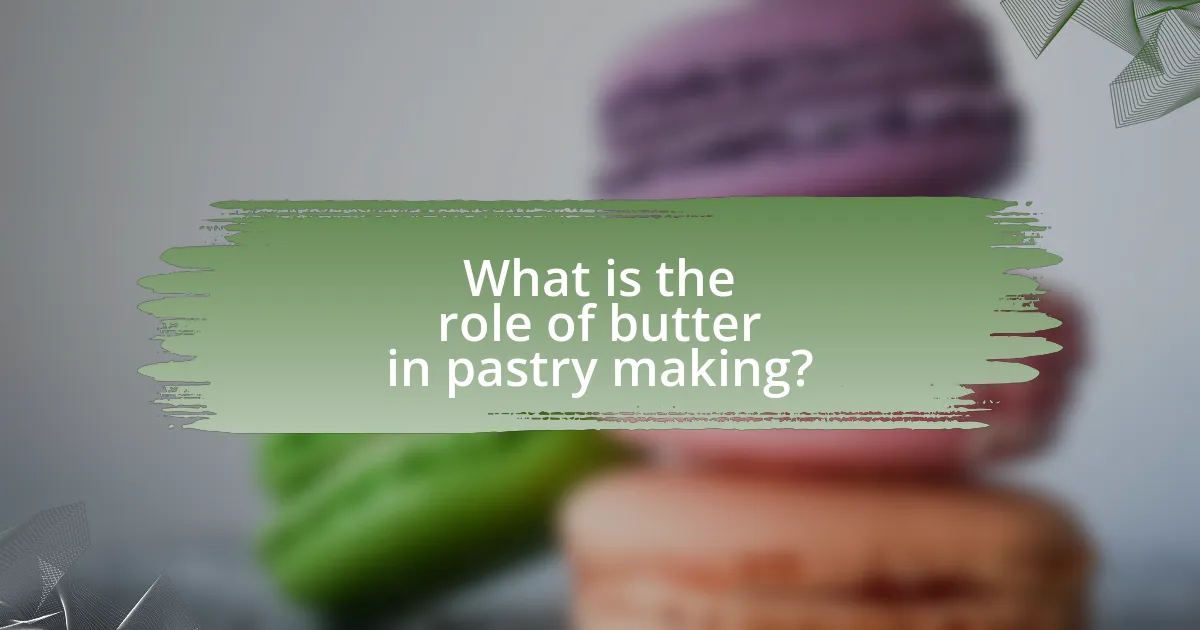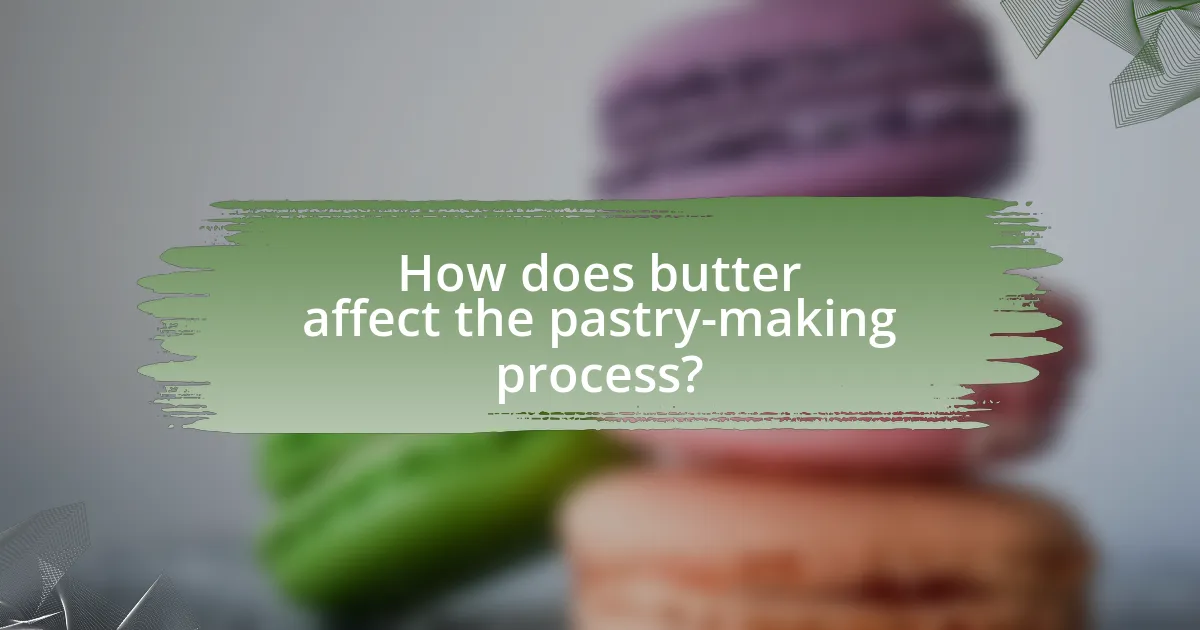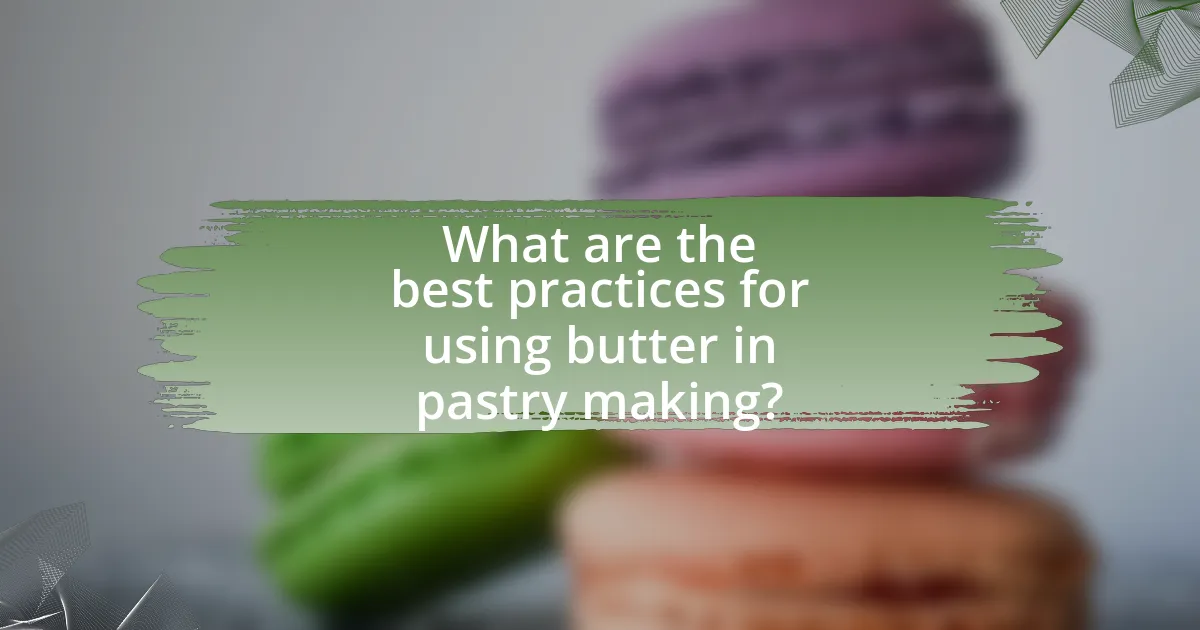Butter is a fundamental ingredient in pastry making, playing a vital role in enhancing flavor, moisture, and texture. Its fat content contributes to the flakiness and tenderness of pastries by creating layers in the dough, while the quality of butter directly influences the final product’s taste and structure. This article explores the significance of butter in pastry preparation, detailing its properties, types, and the impact of temperature and quality on pastry outcomes. Additionally, it addresses common mistakes and best practices for incorporating butter effectively, ensuring optimal results in various pastry recipes.

What is the role of butter in pastry making?
Butter serves as a crucial ingredient in pastry making, primarily providing flavor, moisture, and a tender texture. The fat content in butter contributes to the flakiness of pastries by creating layers when incorporated into the dough. Additionally, butter enhances the overall taste profile, making pastries richer and more appealing. The quality of butter directly impacts the final product; for instance, high-fat butter results in a more tender and flavorful pastry compared to lower-fat alternatives. This is supported by culinary principles that emphasize the importance of fat in achieving desired textures and flavors in baked goods.
Why is butter considered a key ingredient in pastries?
Butter is considered a key ingredient in pastries because it contributes to the desired texture, flavor, and flakiness. The fat content in butter creates a tender crumb by coating flour proteins, which inhibits gluten formation, resulting in a softer pastry. Additionally, when butter is incorporated into the dough, it creates layers that expand during baking, leading to a flaky structure. The flavor of butter also enhances the overall taste of pastries, making them more appealing. Studies have shown that pastries made with higher quality butter yield superior results in both texture and taste, underscoring the importance of using quality ingredients in pastry making.
What properties of butter contribute to pastry texture?
The properties of butter that contribute to pastry texture include its fat content, water content, and emulsifying properties. The high fat content in butter, typically around 80%, provides richness and tenderness to pastries by coating flour proteins, which inhibits gluten formation and results in a flaky texture. Additionally, the water content in butter, approximately 16-18%, creates steam during baking, which helps to leaven the pastry and adds to its lightness. Furthermore, butter acts as an emulsifier, allowing for better incorporation of air and other ingredients, enhancing the overall structure and mouthfeel of the pastry. These properties are essential for achieving the desired texture in various pastry types, such as puff pastry and shortcrust.
How does butter influence the flavor of pastries?
Butter significantly enhances the flavor of pastries by providing a rich, creamy taste that complements other ingredients. The fat content in butter contributes to a desirable mouthfeel and helps to create a layered texture, which is essential in pastries like croissants and puff pastry. Additionally, the Maillard reaction occurs during baking, where the proteins and sugars in butter caramelize, adding depth and complexity to the overall flavor profile. This interaction is crucial in achieving the golden-brown color and nutty aroma that characterize high-quality pastries.
What types of butter are used in pastry making?
The types of butter used in pastry making include unsalted butter, salted butter, and European-style butter. Unsalted butter is preferred for its ability to control the salt content in recipes, allowing for precise flavor adjustments. Salted butter, while less common in pastry making, can be used for added flavor but may alter the intended taste balance. European-style butter contains a higher fat content, typically around 82%, which contributes to a richer flavor and flakier texture in pastries. These distinctions in butter types are crucial for achieving the desired results in pastry quality and texture.
What is the difference between salted and unsalted butter?
Salted butter contains added salt, typically around 1.5% to 2% by weight, which enhances flavor and acts as a preservative. Unsalted butter, on the other hand, does not contain any added salt, allowing for more precise control over the salt content in recipes, particularly in baking where exact measurements are crucial for achieving desired textures and flavors. The American Butter Institute states that unsalted butter is preferred in baking because it allows bakers to adjust the salt levels according to their specific recipe needs, ensuring consistency and quality in pastry making.
How does the fat content in butter affect pastry outcomes?
The fat content in butter significantly influences pastry outcomes by affecting texture, flavor, and moisture retention. Higher fat content in butter leads to a flakier and more tender pastry, as fat coats flour particles, inhibiting gluten formation. This results in a desirable crumb structure. For instance, European-style butters, which contain around 82% fat compared to the 80% found in standard American butters, yield pastries with superior richness and a more delicate texture. Additionally, the fat in butter contributes to flavor development, enhancing the overall taste of the pastry.
Why does the quality of butter matter in pastry making?
The quality of butter is crucial in pastry making because it directly affects the flavor, texture, and overall structure of the pastry. High-quality butter contains a higher fat content and fewer additives, which contributes to a richer taste and a flakier texture in pastries. For instance, European-style butters typically have around 82% fat compared to standard butters with about 80% fat, resulting in superior performance in creating tender and flaky layers. Additionally, the presence of natural milk solids in high-quality butter enhances browning and flavor development during baking, leading to a more appealing final product.
How does the source of butter impact its quality?
The source of butter significantly impacts its quality by influencing flavor, texture, and nutritional content. Butter derived from grass-fed cows typically contains higher levels of beneficial nutrients, such as omega-3 fatty acids and vitamin K2, compared to butter from grain-fed cows. Research published in the Journal of Dairy Science indicates that the fatty acid profile and overall composition of butter can vary based on the cow’s diet, affecting both the sensory qualities and health benefits of the final product. Therefore, the source of butter plays a crucial role in determining its overall quality in culinary applications, particularly in pastry making.
What are the signs of high-quality butter?
High-quality butter is characterized by its rich flavor, creamy texture, and vibrant color. The flavor should be fresh and slightly sweet, indicating that the butter is made from high-quality cream. A creamy texture signifies that the butter has a high fat content, typically around 80%, which is essential for achieving the desired flakiness in pastries. Additionally, high-quality butter often has a pale yellow to deep yellow color, which can indicate the presence of carotenoids from the cows’ diet, particularly if they are grass-fed. These attributes are crucial for enhancing the overall quality of pastries, as they directly impact taste and texture.

How does butter affect the pastry-making process?
Butter significantly influences the pastry-making process by providing flavor, texture, and moisture. The fat content in butter contributes to the flakiness of pastries, as it creates layers when incorporated into the dough. When butter is cut into flour, it coats the flour particles, preventing gluten formation, which results in a tender and crumbly texture. Additionally, the water content in butter helps to create steam during baking, further enhancing the pastry’s rise and flakiness. Studies have shown that the quality of butter, including its fat content and freshness, directly impacts the final product’s taste and texture, making it a crucial ingredient in successful pastry-making.
What techniques involve butter in pastry preparation?
Techniques that involve butter in pastry preparation include creaming, laminating, and rubbing in. In the creaming method, softened butter is beaten with sugar to incorporate air, creating a light texture in cakes and cookies. Laminating involves folding layers of butter into dough, as seen in puff pastry, which results in a flaky texture due to steam created during baking. The rubbing-in technique combines cold butter with flour to create a crumbly texture, commonly used in shortcrust pastry. Each technique highlights the importance of butter in achieving desired textures and flavors in various pastries.
How does temperature affect butter’s role in pastry making?
Temperature significantly influences butter’s role in pastry making by affecting its texture and how it interacts with other ingredients. When butter is cold, it creates a flaky texture in pastries by forming layers as it melts during baking, which is essential for items like puff pastry and croissants. Conversely, when butter is at room temperature, it can lead to a more uniform dough, which is ideal for cookies and cakes where a tender crumb is desired. The science behind this is that cold butter traps air and steam, contributing to leavening, while softened butter allows for better incorporation of sugar and other ingredients, impacting the final product’s structure and flavor.
What methods can be used to incorporate butter into dough?
Butter can be incorporated into dough using methods such as cutting, creaming, and rubbing. The cutting method involves using a pastry cutter or knife to blend cold butter into flour until the mixture resembles coarse crumbs, which is ideal for flaky pastries. The creaming method requires soft butter to be beaten with sugar until light and fluffy, creating an emulsion that adds air and moisture, commonly used in cookie and cake batters. The rubbing method entails using fingers to work cold butter into flour, which is effective for scones and biscuits, ensuring a tender texture. Each method influences the final product’s texture and flavor, demonstrating the importance of technique in pastry making.
What are the common mistakes when using butter in pastries?
Common mistakes when using butter in pastries include using the wrong temperature of butter, not measuring accurately, and selecting low-quality butter. Using cold butter can lead to tough pastries, while melted butter can result in a greasy texture. Accurate measurement is crucial, as too much or too little butter affects the pastry’s structure and flavor. Additionally, low-quality butter lacks the fat content and flavor necessary for optimal results, impacting the overall taste and texture of the pastry.
How can improper butter handling affect pastry results?
Improper butter handling can lead to undesirable pastry results, such as a tough texture or poor flakiness. When butter is not kept at the correct temperature, it can either melt too much or become too hard, affecting the dough’s ability to create layers. For instance, if butter is too warm, it will blend into the flour, resulting in a dense pastry rather than a light and flaky one. Conversely, if butter is too cold, it may not incorporate properly, leading to uneven texture and insufficient rise during baking. These outcomes are supported by culinary science, which emphasizes that the ideal temperature for butter in pastry making is around 50°F (10°C) to achieve optimal results.
What are the consequences of using low-quality butter?
Using low-quality butter can lead to inferior pastry texture and flavor. Low-quality butter often contains higher water content and lower fat percentages, which can result in a soggy or dense pastry rather than a light and flaky one. Additionally, the flavor profile of low-quality butter is typically less rich and can introduce off-flavors, negatively impacting the overall taste of the pastry. Studies have shown that high-fat butter, with at least 80% fat content, is essential for achieving the desired flakiness and richness in pastries, while low-quality butter can compromise these characteristics.

What are the best practices for using butter in pastry making?
The best practices for using butter in pastry making include using high-quality, unsalted butter, keeping it cold, and incorporating it properly into the dough. High-quality, unsalted butter allows for better control of salt levels and enhances flavor. Keeping butter cold ensures that it creates steam during baking, which contributes to a flaky texture. Proper incorporation techniques, such as cutting the butter into flour until it resembles coarse crumbs, help achieve the desired pastry consistency. These practices are supported by culinary science, which indicates that temperature and quality significantly affect the final product’s texture and flavor.
How can one select the best butter for pastry recipes?
To select the best butter for pastry recipes, choose high-fat content butter, ideally 82% or higher, as it provides superior flavor and texture. High-fat butter contributes to a flakier and more tender pastry due to its ability to create steam during baking, which helps in leavening. Additionally, opt for unsalted butter to control the salt levels in your recipe, ensuring the desired taste balance. The quality of butter can significantly impact the final product; for instance, European-style butters are often preferred for their rich flavor and higher fat content, making them ideal for pastries.
What factors should be considered when choosing butter for specific pastries?
When choosing butter for specific pastries, factors such as fat content, flavor, and temperature should be considered. The fat content affects the texture and flakiness of the pastry; for example, high-fat butter (around 82% fat) is ideal for flaky pastries like croissants, while lower-fat butter may be suitable for cookies. Flavor is crucial as well; European-style butters often have a richer taste, enhancing the overall flavor profile of the pastry. Additionally, the temperature of the butter impacts the mixing process; cold butter is essential for creating layers in puff pastry, while softened butter is better for creaming in cakes. These considerations ensure the desired outcome in texture and taste for various pastry types.
How can one ensure butter is at the right temperature for use?
To ensure butter is at the right temperature for use, one should allow it to sit at room temperature for about 30 minutes to 1 hour before incorporating it into recipes. This practice allows the butter to soften adequately, making it easier to blend with other ingredients. The ideal temperature for softened butter is around 65°F to 70°F (18°C to 21°C), which can be verified using a kitchen thermometer. Properly softened butter is crucial for achieving the desired texture and consistency in pastry making, as it helps create air pockets during mixing, leading to a light and flaky final product.
What tips can improve pastry outcomes with butter?
To improve pastry outcomes with butter, use cold butter and incorporate it quickly into the dough. Cold butter maintains its structure during mixing, which creates a flaky texture in pastries. Additionally, cutting butter into small pieces or grating it allows for even distribution, enhancing the overall consistency of the pastry. Research indicates that maintaining a low temperature during the mixing process prevents the butter from melting, which is crucial for achieving the desired flakiness and tenderness in the final product.
How can one achieve the perfect butter-to-flour ratio?
To achieve the perfect butter-to-flour ratio, one should typically use a ratio of 1:2 for a flaky pastry, meaning one part butter to two parts flour by weight. This ratio ensures that the fat coats the flour particles, creating a tender texture while allowing for proper flakiness. Research indicates that this balance is crucial for optimal pastry structure, as the fat inhibits gluten formation, which can lead to a tough texture if too much flour is used.
What are some troubleshooting tips for butter-related pastry issues?
To troubleshoot butter-related pastry issues, ensure that butter is at the correct temperature; cold butter is ideal for flaky pastries, while softened butter is better for creaming methods. If pastries are too greasy, reduce the amount of butter or ensure it is well incorporated into the flour. For tough pastries, avoid overworking the dough, as this can develop gluten. If the pastry is crumbly, consider adding a small amount of cold water to help bind the ingredients. These tips are based on the fundamental principles of pastry making, where the quality and handling of butter directly affect the texture and flavor of the final product.




